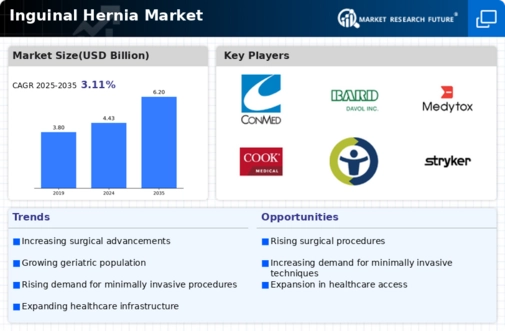Growing Awareness and Education
Increased awareness and education regarding inguinal hernias significantly influence the Inguinal Hernia Market. Campaigns aimed at educating the public about the symptoms and treatment options available have led to more individuals seeking medical advice. This heightened awareness is crucial, as it encourages early diagnosis and intervention, which can prevent complications. Reports suggest that regions with active educational initiatives see a higher rate of surgical repairs, indicating a direct correlation between awareness and market growth. As healthcare providers continue to promote knowledge about inguinal hernias, the Inguinal Hernia Market is likely to experience sustained demand for surgical solutions.
Increasing Healthcare Expenditure
Rising healthcare expenditure across various regions is a significant driver of the Inguinal Hernia Market. As governments and private sectors invest more in healthcare infrastructure, access to surgical treatments for inguinal hernias improves. Data indicates that healthcare spending is projected to increase by approximately 5% annually, which could lead to enhanced facilities and services for hernia repair. This financial commitment allows for the adoption of advanced surgical techniques and technologies, ultimately benefiting patients. As healthcare systems evolve and expand, the Inguinal Hernia Market is likely to flourish, driven by improved access to care and innovative treatment options.
Advancements in Surgical Techniques
Innovations in surgical techniques, particularly minimally invasive procedures, are transforming the Inguinal Hernia Market. Techniques such as laparoscopic surgery have gained traction due to their benefits, including reduced recovery times and lower complication rates. Data indicates that laparoscopic repairs account for approximately 60% of all inguinal hernia surgeries performed. These advancements not only enhance patient outcomes but also drive market growth as healthcare facilities adopt these modern approaches. The shift towards less invasive methods reflects a broader trend in surgery, where patient comfort and efficiency are prioritized, further propelling the Inguinal Hernia Market forward.
Rising Incidence of Inguinal Hernias
The increasing prevalence of inguinal hernias is a notable driver in the Inguinal Hernia Market. Factors such as aging populations and lifestyle changes contribute to this rise. According to health statistics, the incidence of inguinal hernias is estimated to be around 27 per 100,000 individuals annually. This growing patient population necessitates effective treatment options, thereby expanding the market. Furthermore, the demand for surgical interventions is likely to increase as awareness about hernia repair options grows. As more individuals seek medical attention for this condition, the Inguinal Hernia Market is poised for growth, with healthcare providers focusing on innovative solutions to meet patient needs.
Technological Integration in Healthcare
The integration of advanced technologies in healthcare is a pivotal driver for the Inguinal Hernia Market. The adoption of robotic-assisted surgeries and enhanced imaging techniques has revolutionized the way hernias are diagnosed and treated. Robotic systems, for instance, allow for greater precision and control during surgery, which can lead to improved patient outcomes. Market analysis suggests that the use of robotic surgery in hernia repairs is expected to grow by over 15% in the coming years. This technological evolution not only enhances surgical efficacy but also attracts more patients to seek treatment, thereby expanding the Inguinal Hernia Market.


















Leave a Comment